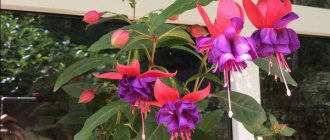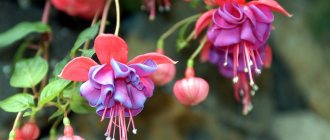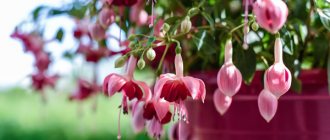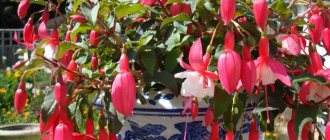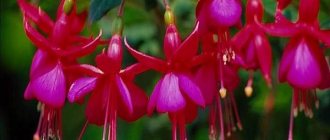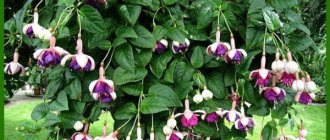Fuchsia does not bloom: reasons
Why fuchsia doesn’t bloom interests not only novice gardeners. This plant is very whimsical and can disappoint even an experienced gardener. There are many factors influencing the growth and flowering of a plant. Here are the main ones:
- illumination;
- air temperature;
- lack or excess of moisture;
- pests and diseases;
- soil composition.
If at least one of the parameters is not met, this leads to a decrease or complete absence of buds. Therefore, as quickly as possible, it is worth finding out why fuchsia does not bloom at home and what to do to correct the situation. There are reasons that can be eliminated immediately and allow buds to appear this year or prepare the bush for flowering next year.
Lack of light
Fuchsia is a light-loving plant; lack of lighting affects the appearance of buds. It is better to place the flower on the eastern, western and southwestern windows (sides of the site). It benefits from fresh air, so it is recommended to send the fuchsia pot to the garden in a pot for the summer, as it is, or replant it on the plot. But you will need to protect the flower from the wind, and on hot sunny days, shade it from direct sunlight.
Fuchsia does not bloom what to do
Important! When the buds appear, under no circumstances should you move or rotate the plant.
Air temperature
For fuchsia, air temperature is of great importance. In summer, on hot days (over 30°C), to prevent the buds from falling off, spray the flower itself and the air around it twice a day. For additional moisture in hot weather, place a small container with expanded clay and water. And the main condition for winter maintenance is the air temperature not higher than 15°C.
Lack of moisture
If there is a lack of moisture, the soil dries out, the foliage falls off, and budding may not occur at all. Good watering with settled water is recommended; there should be drainage at the bottom of the pot so that water does not linger, leading to rotting of the roots.
Pests and diseases
Fuchsia, like all plants, suffers from some diseases. She loves moisture, but its excess can cause gray rot. Brown spots appear on the stems and shoots are affected. The treatment is carried out with copper-containing preparations, such as foundationazole, pureflower.
Important! If root rot has affected the fuchsia root, it can no longer be saved; all that remains is to cut off the shoots and place them in a glass of water for rooting. In order not to provoke the disease, use a coarse-grained substrate, water it rarely but abundantly
Glyocladin is used for prevention
In order not to provoke the disease, use a coarse-grained substrate and water it rarely but abundantly. Glyocladin is used for prevention.
Their insects are loved by fuchsia spider mites, whiteflies, and aphids, so the plant must be inspected for the presence of these pests and treated with insecticides. For example, spider mites can be eliminated with karbofos.
Sometimes yellow spots appear on the underside of the leaf. This disease is called rust, which causes leaves and flowers to fall off. Treatment against it is carried out with the drugs Vertan, Bordeaux mixture, which are diluted strictly according to the instructions indicated on the package.
If the plant is affected by pests, but is still able to bloom normally, you still need to take all measures for treatment.
Features of care and cultivation
In order for the flower to delight you with its blooming and attractive appearance, you should pay attention to the features of caring for fuchsias and their cultivation, which are described below.
Air temperature . Caring for fuchsia at home requires paying special attention to temperature conditions. Comfortable air temperature in summer is from 18 to 20 degrees.
If these indicators are higher or lower for a long time, then the decorative effect of the flower may suffer. In such conditions, the buds begin to fall off, the leaves become lighter and smaller. The plant also slows down in its development, and there is a risk of infection with various diseases and pests.
When the temperature decreases during active growing season, the same effect will be observed. When it is light and warm, the flower begins to actively develop and bloom profusely , usually this occurs from spring to autumn.
At the end of autumn and with the arrival of winter, when it becomes cooler and there is less sunlight, the flower stops in its development, buds stop forming, and the plant prepares to rest. When providing care for fuchsia in winter at home, you should take into account that the air temperature should be about 18 degrees .
Location and accommodation
It is recommended to place fuchsia pots on window sills on the north and east sides. In addition, the flower must be protected from direct sunlight on the leaves using curtains or blinds.
On northern windows in the spring, the plant may not have enough light . In this case, you will have to provide these small bushes with artificial lighting with a phytolamp or a fluorescent lamp for up to 12 hours a day.
On southern windowsills, especially in summer, fuchsia will feel uncomfortable due to the heat . At this time, it is recommended to take the plant into the garden under the trees or put it on the balcony, where the sun’s rays will hit the flower only early in the morning. At noon and until the evening the plant will feel best in partial shade. During the flowering period, it is advisable not to move the fuchsia from one place to another, and also not to turn it to the light in different directions. Fuchsia really doesn’t like this, which is why it can simply shed all its existing buds.
Watering rules
Rational watering of the plant is the most important component of caring for flowering fuchsias. The frequency and quantity of watering a flower is influenced by many different factors, including:
- fuchsia variety;
- location of the flower pot;
- substrate composition;
- stage of growth and development;
- type of pot and its size;
- weather.
When and how often should nutrients be added?
Anthurium is a flower that requires regular replenishment of micronutrients. Fertilizers need to be applied both in the spring and summer, and in the fall. The frequency of procedures is every two weeks.
But not everyone knows how to fertilize anthurium at home in order to make it bloom as long as possible. In winter, the plant is fed no more than once a month, since it is in a dormant state.
For information! Particular attention should be paid to young plants; fertilizers are applied every two weeks for the first 6 months. Fertilizing is carried out regardless of the season. Fertilizer for anthurium should contain a whole range of useful microelements, given its luxurious large leaves and incredibly beautiful inflorescences
It is introduced only when the flower is completely healthy. If pests or signs of specific diseases were discovered, then first of all, you need to get rid of them, and then apply fertilizers
Fertilizer for anthurium should contain a whole range of useful microelements, given its luxurious large leaves and incredibly beautiful inflorescences. It is introduced only when the flower is completely healthy. If pests and signs of specific diseases were discovered, then first of all, you need to get rid of them, and then apply fertilizers.
Fuchsia propagation
Beautiful varieties are propagated at home. The easiest way to get by is with cut cuttings - they are rooted. The cuttings remaining after wintering are quite suitable for growing the root system and subsequent planting in separate pots. Methods of rooting leaves and propagation by seeds are also used.
Propagation by seeds
The technique takes time and experience. First, two plants are grown at home to pollinate flower stalks. After the seeds ripen, they are buried 0.5 cm into the prepared soil. A mini-greenhouse is built, covering the surface of the bowl with film. Once a day, the film is lifted to ventilate and spray the soil.
If everything is done correctly, after 14 days the first shoots will appear. The film is removed, the seedlings are allowed to get stronger and transplanted into separate containers.
How to propagate fuchsia from cuttings
Slices of sprouts are placed in a glass of water or placed in a mixture of peat and sand. Some shoots take root well in ordinary universal soil. After 14 days, the fuchsia cuttings will give roots. They are given a week to mature and transplanted into a container with soil.
On a note! The first pot is chosen with a diameter of up to 10 cm. This way the root system will quickly master the volume of the container and direct its forces to the collection of green mass. After a year, the new flower is transplanted according to standard rules, that is, into a pot with a diameter of up to 15 cm. After a year, the first flowers will appear.
Propagation by sheets
To make the leaf take root, do this:
- choose a healthy leaf with a long stem;
- prepare a mixture of peat and sand or nutritious universal soil;
- moisten the soil abundantly;
- plant a leaf, water it again;
- cover the sheet with a glass or jar;
- for 60 days, the leaf is sprayed with warm, settled water, and the “greenhouse” is ventilated;
- after the allotted time, shoots will appear on the cut of the stem;
- remove the glass, and the volume of liquid for spraying is reduced by 2 times.
Spraying is stopped 5-7 days after the roots form. The roots grow for another 2-4 days. Then the leaf is transplanted into a separate pot with universal soil.
How to make fuchsia bloom profusely
To create a beautiful shrub, a crown is formed by pinching. In February, it is transplanted by transferring from a small pot to a larger one just a couple of centimeters. Fuchsia will build up its root system and spend less energy on flowers.
Since the shoots of the plant have grown over the winter, the central stem and several branches are selected to form a crown and pinched at the required height. After a few weeks, the fuchsia will be covered in flowers.
Important! Excess shoots can be placed in water until roots appear, and then planted. The plant needs constant feeding, this is especially important during the flowering period.
How to feed fuchsia for abundant flowering? From spring to autumn, feeding (root and foliar) is carried out every week. The sheet is treated with plantofol in combination with zircon and epin. This will prevent the buds from falling off and will affect the abundance of flowering
The plant needs constant feeding, this is especially important during the flowering period. How to feed fuchsia for abundant flowering? From spring to autumn, feeding (root and foliar) is carried out every week.
The sheet is treated with plantofol in combination with zircon and epin. This will prevent the buds from falling off and will affect the abundance of flowering.
Applying fertilizer to the soil
How to make fuchsia bloom profusely
Flowering largely depends on the composition of the soil, what fertilizers are applied (dry or liquid) and fertilizers (mineral or organic). You can purchase ready-made soil at the store or prepare it yourself. The soil is suitable from a mixture of coconut fiber and any universal soil with the addition of vermicompost for softness and looseness.
Regardless of where you purchased the soil, it should definitely be calcined at high temperatures to destroy all microorganisms, disease spores, and weed seeds. Or this can be done by strong cooling: the soil is moistened with water, taken out to a frost not lower than −10°C and left for several days. Freezing destroys all pests, but, unfortunately, beneficial bacteria too. Such procedures are carried out 2-3 times, then the soil is watered with biological products, for example, phytosporin, which contains microorganisms. In this state, the soil is left in a bag for 2 weeks.
Fertilizers for fuchsia are selected depending on the growth phase:
- young specimens need fertilizing with a high nitrogen content to increase green mass and the growth of young shoots;
- to make fuchsia cover itself with abundant flowers, you need to add fertilizers that include phosphorus and potassium;
- when treating the bud with the drug, the color turns out bright and saturated;
- It is good to alternate watering flowers with mineral and organic compounds.
Important! Under no circumstances should you water plants with fertilizer in dry soil. For 2 - 3 hours, the soil is spilled with clean, settled, warm water, and only then solutions with useful microelements are poured
Knowing how and what to feed fuchsia, you can speed up plant growth, help it bloom on time, and increase resistance to various diseases.
Time and quantity of watering
During the period when the plant is actively growing and blooming, watering should be plentiful and frequent. There is an opinion that 90 out of 100% of the life activity of fuchsias depends on irrigation. Although they are considered to be moisture-loving, the majority of flowers die from overwatering, and it is impossible to save a flooded plant. For example, in indoor conditions, if fuchsia has dropped its leaves and buds, you need to check the soil for moisture. If it is very damp, it is worth taking the flower out of the flowerpot, with the remaining roots (white in color) transplanted into another soil, covered with a bag and left in the shade.
Overdrying the soil is also dangerous, as leaves and buds may fall off. The flowerpot is completely lowered into the water until it fills with water, and the plant itself is sprayed with a spray bottle. In general, it is better to spray fuchsia more often and generously than to flood it.
Both experienced gardeners and novice amateurs can cope with fuchsia only if they do everything as described above
It is very important to know how fuchsia grows and what to fertilize it with, then the result will not be long in coming. The plant will thank you with abundant bright flowering
Selection of ready-made fertilizers
If fuchsias are grown in pots, preference should be given to complex mineral fertilizers, or organic ones sold in stores. When planting in flower beds, you can use folk remedies, but be careful - the exact composition there is unknown.
Mineral
There are no separate fertilizers for fuchsias. At least they are not on mass sale. Suitable preparations for beautiful flowering plants:
- indoors - when grown in pots;
- street - in a flowerbed.
Root
In spring, fuchsia must grow green mass; it needs nitrogen. Even before the buds awaken, the bush is transferred to a warm place (temperature about 20 ° C), bright lighting is provided, and one of the nitrogen-containing preparations is given.
At the beginning of the growing season, watering with the following solution (per 1 liter of water) showed good results:
- urea – 3-4 g (1 tsp);
- magnesium sulfate – 1.5 g (1/3 tsp).
In spring, mineral complex preparations with a high nitrogen content are given every 2 weeks. As soon as the first buds appear, use any fertilizer for flowering crops with approximately the same N:P:K content, for example, 10-10-10, 14-14-14, 20-20-20. If you couldn’t find any, you need to make sure that the ratio of potassium and phosphorus is not very different, and there is less nitrogen.
There are many drugs in different price categories, the following brands have proven themselves:
- Agricola;
- Master;
- Blank sheet;
- Fertika;
- Royal Mix;
- Compo;
- Hylea;
- Biopon;
- Rosafert.
Many outdoor gardeners successfully fertilize fuchsias with ammophos.
Autumn fertilizing for crops - only mineral, without nitrogen:
- Pekacid;
- potassium monophosphate.
Long-lasting
Long-acting fertilizers are used in the garden or potted crops; the validity period is indicated on the package, usually from 2 to 6 months. It is important to read the instructions carefully - the drug can only be intended for containers (pots); in open ground it will be ineffective.
It is recommended to pay attention to TM fertilizers for flowering plants:
- Osmokon;
- Florium;
- Mivena;
- Ecote;
- Royal Mix Longcat.
Most phosphorus fertilizers, for example, superphosphate, last about 3 years, but really begin to work the next season after application in the fall. To immediately replenish P deficiency, use an extract or quick-acting preparations containing K - Pekacid, potassium monophosphate.
Foliar
It is useful to feed fuchsia for abundant flowering not only at the root, but also by spraying it on the leaf. This way microelements are better absorbed, nitrogen, phosphorus and potassium act faster.
In flower beds and pots you can use chelates for flowering plants, ordinary water-soluble fertilizers, and potassium monophosphate. Ready-to-use sprays are produced for indoor plants - they do not need to be diluted:
- NPK standard;
- Blank sheet;
- Dr. Foley;
- Effect;
- Turbo.
Often stimulants, fungicides and/or insecticides are added to such fertilizers, which is very convenient. To know exactly the purpose of the drug, you need to read the instructions.
Organic
Such fertilizers for fuchsia grown in pots must be purchased in the store. They are made on the basis of humates or peat, with mineral additives:
- Stimovit;
- Popcon;
- Organic;
- Agriline;
- Reasil;
- Flora;
- Stimulus.
In Western countries, feeding fuchsias with preparations based on fish or algae is popular. They are few and far between in our country and are expensive. On the market, such fertilizers may belong to the group of biostimulants:
- Agrofish;
- Fitomare;
- Bio Fish.
In open ground, fishmeal can be used as a feed for fuchsias - it contains nitrogen, phosphorus, and microelements, but potassium will have to be given separately. The fertilizer is valid for 3 years, so it is better to apply it to the entire flower garden (50 g/sq. m) than to the holes.
Transplanting a plant
Fuchsia is considered a fast-growing plant, which is why it must be regularly replanted in a container of suitable size, which should be 3 cm larger than the previous one. It is best to transplant in the spring - during the awakening and growth of the plant.
It is recommended to use a ceramic pot, as it can protect the root system from overheating in the summer. Do not forget about the drainage layer, the thickness of which should be 2-3 cm. The drainage layer protects the root system of the plant from rotting. It is recommended to use a purchased soil mixture specifically for flowering indoor plants as a substrate.
You can also prepare the soil yourself. To do this, the following types of soil are mixed in equal parts:
- turf land;
- leaf soil;
- peat;
- humus;
- coarse river sand.
Transplantation is carried out using the transfer method: a little prepared soil is poured into the container onto the drainage layer, after which the plant is carefully removed from the old pot and, together with the earthen lump, is placed in a new container. All voids on the side must be filled with soil mixture.
After transplantation, the flower is placed on a shelf with diffused light. It is also necessary to cut the flower stems to 1/3 of the length. The leaves are sprayed, and the substrate is watered with settled water and wait until all the excess water drains into the pan; the excess moisture must be drained.
After the transplantation procedure, the plant is not fed for a month. Now you need to wait a couple of months for the fuchsia to please you with abundant flowering.
If you are planning to propagate a flower, then it is best to do this by cuttings. Fuchsia can also be propagated from seed, but this method is rarely used, since a lot of time passes from the moment of sowing until a flowering plant is obtained.
Watering fuchsia
Water fuchsia moderately but regularly. The water should be left standing for at least a day, at room temperature or slightly higher (up to +28o).
Excessive watering is undesirable - stagnation of moisture in the soil can lead to rotting of the roots. At the same time, overdrying leads to the shedding of leaves.
To maintain balance, the plant is watered when the top layer of soil dries a couple of centimeters.
In winter, fuchsia is kept cool and requires less moisture . Watering is significantly reduced and the plant is watered only as needed when the soil has significantly dried out by half the pot or more.
Pruning and shaping fuchsia after flowering
Fuchsias respond well to heavy pruning.
Flowers grow only on young shoots. To form flowering next year, at the end of winter - beginning of spring, fuchsia is heavily pruned. About two-thirds of the above-ground part of the plant is removed, incl. dead and diseased parts of it. This pruning rejuvenates the fuchsia and leads to abundant flowering in summer and autumn.
- Before pruning (12 hours before), water the plant.
- Remove dead, damaged, thin and crossing branches.
- Cut out weak, broken and damaged branches back to the main stem.
- Pruning vertical stems, from 1/3 to half of summer growth.
- Trimming healthy stems. The result of pruning is that each branch should have no more than three new buds. The side branches form the shape of the above-ground part of the plant; pruning them is intended only for this purpose.
- Remove old leaves (to prevent pests).
Tips and warnings
Each time the stem has grown to two internodes, pinch it above the second internode to improve branching. Repeat this procedure two to three times during the spring and summer. As soon as flowering on the stems stops, the stem is cut back to the next internode.
Trimming multiple fuchsias with one pair of scissors can transfer pests from the infested plant to others.
Diseases and pests. Fuchsia is damaged by aphids, whiteflies, spider mites, powdery mildew, gray mold and rust. For a detailed description, see the corresponding chapters: “Diseases” and “Pests”.
Main problems when growing
Fuchsia leaves are falling off. Probable causes: warm dry air, insufficient watering or lack of light.
Fuchsia's buds are falling off. Probable causes: violation of the watering regime (too much or too little water), insufficient lighting, too warm air, or perhaps the pot was moved to another place, or turned in relation to the light.
Short flowering period. Possible reasons: the plant is kept in a warm room in winter and watered abundantly, or it is fed little and not watered enough, or it does not have enough light during the growth period.
Brown spots with yellow edges on the leaves. Probable cause: waterlogging of the soil during the cold season.
Fuchsia - growing problems
Wintering fuchsias causes a lot of problems. During the cold period, plants are transferred to a cool room; at temperatures above 15 ° C and poor lighting, they become very stretched. If there is no suitable room, then you will have to create artificial lighting for the bushes with fluorescent lamps. Constant flowering leads to exhaustion, so cool wintering on loggias is the best option.
In making fuchsia bloom at home, Zircon is a great help; this fertilizer causes buds to appear in even the most fastidious varieties. The beginning of the formation of inflorescences is the most important period; at this time, it is not advisable to twist the pots around an axis or move them to a new place. In hot weather, the plant often sheds its leaves; you can lower the temperature with air conditioning or by spraying the green mass. If harmful insects appear in summer, use Aktara or other insecticides.
- Author: Maria Sukhorukikh
Rate this article:
- 5
- 4
- 3
- 2
- 1
(1 vote, average: 5 out of 5)
Share with your friends!
How to care during flowering
A flowering plant requires special care. Basic Rules:
The flower pot must be placed on the sunny side. However, during hot summers, it is necessary to ensure that the plant receives shade to reduce the risk of yellow spots on the leaves. It is necessary to promptly remove all dead leaves and young shoots growing from the root. The plant needs to be watered every 4-5 days
It is important to ensure that the water does not accumulate and spreads well throughout the pot. You need to water the soil only after it is completely dry. Once a week, you need to loosen the soil in a pot of geraniums.
This will reduce the risk of rot on the roots and saturate the soil with oxygen.
Caring for geraniums during flowering
During the flowering period, a large amount of nutrients in the soil can harm the inflorescences and shoots. However, with prolonged flowering, it is necessary to use potassium fertilizers. You can feed the flower with water with iodine. To do this, you need to dilute a drop of iodine in a liter of liquid. This watering will make the flowering lush and the color of the buds bright.
Important! During the flowering period, replanting the bush and cutting young shoots is not carried out. It is also not recommended to trim bushes
How to transplant fuchsia
Replant once a year in the spring until March 15. Such regularity will ensure free growth of roots and normal development of the bush.
Planting and caring for fuchsia is organized as follows:
- Choose a new pot. It should be 40-50 mm higher and wider than the old one.
- Fill with drainage and soil. If there is no ready-made substrate at hand, take sand, peat, and leaf soil in equal parts. Mix, bake in the oven for about 30 minutes at +200 C. Then moisten with mineral fertilizers and plant fuchsia.
- Before transplanting, the leaves are cut off completely, and the shoots are cut to a third of their length. Dry shoots are removed. They replant by transshipment - they do not remove the soil from the roots, but transfer the whole thing into a new pot.
- The new prepared pot should only have drainage and 3-4 cm of soil on top of it. When the plant is rolled over, add soil into the gap between the old clod of earth and the walls. They pour the earth "heaped". Shake the pot a little or lightly tap the walls - the soil will compact a little.
- Then add more soil, water it generously, and place the pot with the flower in a tray to drain for 2 hours.
- After draining the excess liquid, soil is added to the container and the fuchsia is placed in a permanent place. Do not water the filled soil.
Important! After transshipment, the flower is given time to recover. The first watering is organized no earlier than after 10 days, fertilizing - after 14 days.
Fuchsia - home care
When it comes to caring for fuchsia in your home, you need to focus on the conditions in the apartment. Compact shapes, resistant to bright light, suitable for window sills. Shade-tolerant species can be placed in pots inside the room. Ampel varieties feel good on suspended structures, standard ones - on a table or a special stand. If you do not know the acquired variety, then create average conditions for your fuchsia, adjusting its formation as it develops and taking into account the growth force.
Homemade fuchsia flower - watering
In the absence of fertilizers, the plant can develop, but without water, any organism will quickly wither
When studying the problem of how to care for fuchsia at home, you need to pay special attention to watering. Excess moisture leads to rotting and disease, but it is advisable to ensure that the soil in the pot is completely saturated with liquid
Watering is carried out when the top layer of soil dries. Blooming fuchsias require this procedure more often when cared for in summer. In hot weather, water the plant every 3 days or more often.
Fuchsia - feeding at home
Fertilizer application is beneficial during the growth period - from April until the arrival of cold weather. When caring for a fuchsia flower, it requires one feeding with complex preparations for 2 weeks. In winter, the plant is in a dormant stage and does not need stimulation. If you have transplanted, you should not rush; resume feeding a month after the fuchsia has adapted to the new conditions. Both root and foliar methods of applying fertilizers are suitable.
Fertilizers are not applied to dry soil; before this procedure, the soil should be watered a little. To stimulate the formation of buds, the crown is treated with Zircon, then the fuchsia needs phosphorus-potassium fertilizers. Balanced fertilizers of old and new brands for flowers are suitable - “Spring Effect”, “Planta Miracle-Growth”, Pokon, and other proven preparations.
Feeding fuchsia
For the full functioning of flowering plants, it is necessary to carry out regular fertilization with mineral and organic preparations. They have a number of advantages:
- stimulate growth;
- prolong flowering and budding;
- increase immunity;
- help to survive under unfavorable conditions;
- protect against pests and many diseases;
- saturate the culture with important trace elements and minerals (boron, nitrogen, zinc, selenium, phosphorus, potassium, iron).
Fertilizer must be applied to support the root system and above-ground parts of the fuchsia. Feeding the roots is done by watering the soil, followed by the plant absorbing nutrients that enter the soil. The green part of the fuchsia is fed through the bottom of the leaves.
The fertile layer should not be deficient or oversaturated with nutrients: this can destroy the plant. When planting or transplanting, flowers are not fertilized for 3 weeks after the procedure, since this period is important for the adaptation of the crop. Young shoots receive nutrition from the new soil - additional fertilization can have a detrimental effect on fuchsia.
At the end of the adaptation period, you need to establish a feeding schedule. It is recommended to fertilize once every 2 weeks during the active growth period. The soil must be optimally moistened.
Young fuchsias love nitrogen fertilizers (the products are applied after the first pair of leaves appear), while adults love potassium and phosphorus fertilizers. Nitrogen activates shoot growth and increases the green mass of fuchsia. Phosphorus and potassium contribute to the formation of a large number of buds, guaranteeing their correct shape and bright color.
It is better to apply fertilizer little by little, but often. Can be fed 2-5 times a week in small doses.
There are several rules for fertilizing fuchsia:
- Nutrition is provided only for healthy plants.
- Sick flowers must first be treated and then fertilized.
- The soil must be moist.
- Fertilizing is not carried out from October until the onset of spring.
- Young cuttings are not fed due to an inferior and weak root system.
- If fuchsia does not bloom, you need to check the condition of the roots: they may rot. It is necessary to first treat the plant, and only then fertilize it.
To increase the immunity of fuchsia, its resistance to diseases and harmful insects, experienced plant growers recommend the Epin-Extra product.
Organic fertilizers
Fertilizers based on organic matter have shown good results. Let's consider the most effective of them.
- Fertimix, created on the basis of vermicompost, is applied at the rate of 20 ml per liter of clean water. The plant is watered with this composition once every 2 weeks. The product promotes the formation of strong buds and leaves, gives a bright color to the green part and flowers.
- Bone meal is an effective soil-feeding fertilizer. It is recommended to add it 1 tbsp. l. into the pot, sprinkling the soil without further loosening.
- The organic preparation in liquid form “Living Power for Flower Crops” from the Peter Peat brand, containing humic acids, has proven itself well. For root feeding, you need to prepare a solution from a bucket of water and 30-50 ml of product. Fertilize fuchsia with this substance every 14 days. For spraying, dissolve 10-30 ml of the drug in the same amount of liquid, irrigate the plant 2-3 times a month.
- Peat oxide is applied in diluted form, preparing a 1% solution for weekly foliar feeding. The substance promotes nutrition of leaves and the formation of new shoots.
How is growing in open ground different from keeping a house in a pot?
Fuchsia is known as a house plant, but outdoors it can present itself in a different way. Garden fuchsia includes the best qualities. Having transplanted the plant into open ground, you will no longer recognize it, it will surprise you with its flowering, and its rapid growth and powerful growth will turn your flower into a small tree.
Fuchsia blooms in the open ground all summer, and in the fall care consists of digging up the plant and sending it to spend the winter in a cool and bright room. Just as with indoor growing, outdoor fuchsia bottoms are suitable for windless areas, preferably under the wall of a building, with sufficient lighting. Unlike home fuchsia, neutral soil may be suitable. Despite being grown outdoors, fuchsia still needs periodic watering.
A plant in open ground always grows faster and has more lush flowers than representatives living in apartments. Outdoor care involves preparing the plant for winter, which involves digging up the flower and gradually reducing its watering. During wintering, homemade fuchsia will only need a cooler place.
Reference! If you live in a private house, your choice should fall on growing fuchsia in open ground. The plant is more suitable for growing in the garden than others, and we described above how to preserve it until spring.
Reproduction
Indoor fuchsia is propagated by cuttings and seeds.:
Propagation by cuttings is best combined with the timing of pruning. To root the shoot, it is immersed in water or a special temporary soil consisting of a mixture of wet sand and vermiculite. The process of root development can last from three days to one month. During rooting, the cuttings are periodically sprayed with a spray bottle. Read about how to grow fuchsia from leaves here.- Propagation by seeds involves sowing into appropriate soil. Seeds usually germinate well, the main thing is to keep the soil moist. As it grows, the fuchsia is transplanted into a larger pot: if watering has to be done daily, this may indicate that the flower is cramped, and it’s time to enlarge the pot.
Below is a visual video about the propagation of fuchsia:
How to fertilize correctly?
A prerequisite for bright fuchsia flowering is fertilizing with fertilizers. Fertilizers should be purchased in special stores, since ready-made fertilizers maintain the ideal balance of organic minerals and elements specifically for this type of plant.
Do not overdo it with fertilizing; if there is excess fertilization, fuchsia begins to grow actively and practically does not produce flowers. It is best to feed the flower no more than twice a month.
It is not recommended to use fertilizers of unknown origin, and fertilizers that are intended for other types of plants. In winter, fuchsia is dormant and does not need fertilizer.
What do fuchsias not like?
He is picky about moving from place to place and does not like
when it is turned over.
It can be either an illuminated sunny place without direct sunlight, or artificial lighting. ... If there is not enough light, then the fuchsia
will grow, stretch out and deprive you of charming flowering.
Interesting materials:
What are the angles in a regular triangle? What are the angles in a trapezoid? After how many years do the days of the week repeat? How long does it take for Instagram technical support to respond? How to translate numbers to a minus power? What is bigger than double and float? What will happen without Adobe Flash Player? What will happen to the pawn when it reaches the end? What does a personal blog on Instagram give? What does plus and minus give?
Pinching and trimming
Indoor fuchsia flowers form on young shoots. In order to have more of these shoots, it is recommended to trim the plant regularly, as well as pinch out young shoots.
Pinching is an effective method to make fuchsia bloom more abundantly. Using pinches, you can form the desired shape of the plant: give it the appearance of a ball, a bush or a small tree in the form of a bonsai.
Depending on the variety, fuchsia can grow up to 3 m in height and even higher. When kept indoors, such a plant will be quite difficult and impractical to grow. Low-growing varieties or ampelous fuchsia are preferred for the room. The plant is pruned twice a year: in autumn, at the end of flowering, in October, and also in winter, in early January.
When you prune for the first time in the fall, you need to remove all faded branches at a height of 2 cm from the dormant buds. It is necessary to carefully inspect each branch for the presence of pests, remove all excess seed pods and outdated flower stalks. If you find pests, you need to cut off severely damaged parts of the plant and treat the entire flower with an insecticide.
The second pruning is carried out in early January to finally form the crown of the tree. If the fuchsia was in the garage or basement in winter, then the plant is pruned only in the fall. In spring, only the resulting dry leaves and shoots need to be removed.
If the fuchsia spent the whole winter in the room, then in winter it must be trimmed. Using garden shears or clean pruning shears, remove all thin and long shoots. As a rule, such shoots will not bloom luxuriantly and will spoil the decorative appearance of the entire bush.
With periodic pruning, the plant will grow in width instead of height. It is best to prune old, woody shoots as well, since they consume nutrients and almost never produce flowers. All flowers bloom only on young branches. Soon a beautiful and strong bush begins to form.
If you want to form a bonsai tree from a fuchsia tree, then you need to leave one shoot or, conversely, several such branches that can be easily twisted together into a common trunk. At the same time, the tops are pinched to form a lush crown of the tree.
Pinching should be done in winter, when the plant is dormant. All unnecessary shoots are removed, leaving only a few branches on the central trunk. We'll have to see what comes of it in the spring. If the crown of the plant is not yet fully formed the way you would like, the flower must be pruned again in the spring.
Different, bright and multi-colored indoor fuchsias are considered a precious exhibit in the collection of every gardener. If you still haven’t purchased this indoor flower or doubt that you won’t be able to care for the flower, then it’s in vain. Even a beginner can grow and care for fuchsia at home if the basic rules are followed.
Pruning fuchsia
Proper pruning of the plant will not only give the bush a neat appearance, but also stimulate more abundant and lush flowering. In addition to pre-transplant pruning, there are other types of pruning.
Pruning is carried out throughout the summer. Long shoots are selectively pruned, which will subsequently produce new flowers in the fall.
A crown of the correct shape can be formed by evenly cutting off the shoots, leaving two to four pairs of leaves on them.
The standard form of fuchsia looks very beautiful. It's easy to get. It is enough to remove all the side branches of the plant to the desired height. For stability, the central stem of the flower is attached to a support.
And, of course, immediately after rooting the cutting, you need to take care of the future type of the plant. Once established in the permanent pot, be sure to pinch off the top.
Fuchsia - growing features
For fuchsia, cultivation is suitable at a temperature of 18-22 °C in the warm season; in winter we reduce the temperature by 3-4 degrees. Climate fluctuations cause buds to fall off. When it gets cold or very hot, the leaves become smaller, change color, and the risk of fungal infections increases. By the end of autumn, fuchsia is preparing to rest, the formation of new buds stops, the growth of shoots and leaves slows down.
Soil for fuchsia at home
An elegant and decorative home flower, fuchsia is an undemanding plant; it grows in any fertile soil with a neutral reaction. You can improve the quality of the soil by adding useful components to it. To grow and care for adult fuchsia at home, take a mixture of peat, humus, turf soil, compost, leaf soil, and clean river sand.
Pinching fuchsia at home
Without normal care and formation of the cuttings, the flowerpot develops randomly, becomes elongated, and produces few flower stalks. Some varieties practically do not branch on their own in nature; they have to be stimulated artificially. There are no difficulties in the question of how to pinch fuchsia at home. By performing this necessary operation, the grower removes the growing point, doubling the number of shoots. In winter, in this way we help the flowerpot not to stretch out. At home, ampelous forms of adult fuchsia are pinched over 2-3 pairs of leaves, bush forms - over 3-4 internodes.
How to form fuchsia at home?
It is advisable to replant the old plant annually and form the crown. In March, flower growers are engaged in removing shoots and feeding bushes. After stimulating procedures, fuchsia wakes up, cultivation and care according to all the rules of agricultural technology starts the buds to grow even on old woody parts of the shoot. Bush forms are given time to grow, shortening the crown when the required height is reached. The formation of adult fuchsias is completed by the beginning of April.
Rules for the formation of fuchsia:
- The first time we pinch a fully rooted cutting above the 3rd pair of leaves.
- We shorten the side shoots at the same time to give the fuchsia the required shape.
- A compact plant is obtained by pinching over the 2nd pair of leaves; full formation takes up to 3 months.
- For flowering, pinching should be stopped after obtaining a strong bush. It must be remembered that buds take from 6 to 12 weeks to form.
How to replant fuchsia at home?
The time to transfer the plant to a new pot comes when the entire earthen ball in the container is filled with the root system. If small roots begin to appear from the drainage hole, then you should start working. Fuchsia is transplanted at home into a pot 2-3 cm larger. Do not compact the soil too much with your hands; light tapping is enough. After a while it will sit down on its own; you can add a little soil if necessary.
Fuchsia flower - description
People have been breeding these flowers with amazing decorative properties for over three centuries. Its wild forms are found everywhere in the New World, inhabiting the expanses of America, New Zealand and many tropical islands. Cultivated fuchsia at home quickly spread in Europe; now hundreds of varieties and hybrids of this crop decorate flower beds, homes, balconies and terraces in all countries of the world.
Bolivian fuchsia and fuchsia magellanica are tall growing shrub-like forms with evergreen leaves. These types are used to decorate windows and walls. Fuchsia brilliant can bear fruit with edible berries and bloom for a long period. She decorates the garden all summer with her magical appearance. This decorative species became the ancestor of numerous forms of modern garden and indoor fuchsia.
There is bush and upright fuchsia that grows up to half a meter in height; growing and caring for these forms at home differs significantly. Hybrid plants are famous for their wonderful decorative highlight - the upturned cups of their flowers have a color that can be radically different from the color of purple, white, red or pink petals.
Classification of fuchsia by petal color:
- plain,
- bicolor,
- tricolor,
- variegated.
Classification of fuchsia according to growth form:
- bush,
- ampelous,
- semi-ampel.
When to feed and water indoor plants
Although plants require minerals for good growth, when feeding, you need to take into account that different types of fertilizers can be used depending on the time.
Applying liquid fertilizers is an important step in caring for any flower.
For your information! Flowers may only need fertilizing during the active growing season. The rest of the time it is harmful to do this. However, you need to understand that the characteristics of the growing season may differ for different species. For example, at home, some flowers may not have a dormant period at all. Thus, their growing season occurs throughout the year.
Spring and summer are the times when you need to feed all the flowers growing at home. Increasing the duration of daylight hours promotes active growth and flowering.
The beginning of the growing season falls at the end of February or March. The exact time depends on the climatic and weather conditions of the region. For most plants, this period ends in autumn. Reducing daylight hours indicates to houseplants that a dormant period is about to begin. This usually happens in October. Therefore, for most types of feeding, feeding ends in September.
During late autumn and winter, you need to monitor whether the time of rest has come for a particular flower. If this is the case, then no fertilizing is applied at the specified time.
However, a situation may arise where flowering continues into late autumn and winter. In this case, you can be sure that the dormant time has not come for this flower, which means you need to continue to feed. It is worth considering that in this case their intensity must be reduced. In winter, plants lose the ability to absorb the same amount of fertilizer as in summer. If this is not observed, then house flowers may get burned from excessive amounts of fertilizing.
Diseases and pests
The main problems are dropping buds and lack of flowers. Fuchsia sheds flower stalks due to improper watering, lack of fertilizing or insufficient light. If the leaves fall along with the buds, it means the plant is hot. But excessive watering is also harmful, the leaves turn yellow and dark spots form on them.
Reasons for the lack of flowers:
- Delay in pinching, pruning. Pruning is carried out in early spring. After skipping a period, the flower is left in its original form. But in this case, the next trimming is more aggressive; it is needed for rejuvenation.
- Too hot and dry rest period.
- Incorrectly selected soil. Self-mixed soil can be heavy, so beginners are advised to buy a universal soil mixture.
- Lack of or irregular application of fertilizers.
- Pot too big.
Important! There will be no flowers when fertilized with nitrogen compounds. The component is needed to gain green mass; it does not help form buds.
Diseases are always associated with improper care:
- Untested soil is the reason for the appearance of parasites. The bush dries, the root shoot changes color. The plant is treated with fungicides for indoor flowering varieties.
- The brown tint of the roots during transplantation indicates the beginning of the rotting process. The affected shoots are removed and the roots are washed. Place the flower in warm water so that it produces new roots. Then transplanted into a pot with soil.
- Yellow leaves - lack of manganese, brown - molybdenum. To prevent disease, choose balanced ready-made mineral fertilizers.
Regardless of the presence/absence of parasites, prevention is carried out with insecticides in the summer season. Regularity – once a month. If whiteflies or spider mites are detected, treatment is carried out more often. The compositions are sold ready-made and used according to the instructions.
Fuchsia diseases
To begin to properly fix the problem, you need to determine the cause. Common options according to leading botanists:
- the appearance of pests;
- bad light;
- lack of nutrients.
What to do if fuchsia leaves curl
The problem of reducing daylight hours is easily solved by organizing illumination with lamps in winter, and in summer the flower should be moved to the most illuminated place, but avoid direct rays of the sun. This causes the leaves to turn yellow.
In good light, leaf curling and yellowing indicates a lack of macro and microelements. Potassium, zinc, molybdenum are the main flower nutrition in case of this problem. The sheet plate will tell you which element is missing.
Note! The leaves curl upward due to a lack of zinc; inside - molybdenum. The shape of the leaflets changes with a lack of minerals in general
Pests and parasites can cause leaves to curl in a young plant. In a flower garden, caterpillars undermine the roots and stems, the leaves wither and curl. Removing the caterpillars and treating with insecticides will save the flower.
Aphids and nematodes can settle on the leaves. They are hardly noticeable because they bite into the leaf. Having lost their juices, the leaves curl. Control measures are the same as for whitefly. Preventative measures with insecticides will kill the clutch of insects in the early stages of reproduction.
Caring for indoor fuchsia
Watering and air humidity
I have a clear schedule for watering different types of plants, where I simply included fuchsia. Fuchsia loves abundant watering. The control indicator is the drying out of the top layer of soil. Sometimes I give the bush a shower, which he perceives very favorably.
Important: excess water from the pan must be removed immediately so as not to provoke rotting of the roots!
Indoor fuchsias are suitable for average air humidity. That is, in the summer they will not be hindered by spraying.
Feeding
Fuchsia is sensitive to lack of nutrients. I apply fertilizer every week, but in portions half as large as indicated in the instructions. I alternate organic and mineral complex fertilizers for beautifully flowering indoor plants. Fuchsia needs active feeding from spring to autumn.
By analogy with other plants, I started adding wood ash to the surface of the soil once every 14 days (1 level teaspoon).
Diseases and pests
It has been noticed that most often fuchsia is affected by gray mold. It is enough to fail to keep track of the amount of moisture added several times or not to remove the water from the tray, and alarming spots and a grayish coating appear on the lower leaves and stem.
To avoid trouble, I started using Glyokladin tablets. The drug acts as a preventive and therapeutic agent, destroying the cells of pathogenic bacteria and fungi. It is economical and safe for pets. According to the instructions, the tablet must be buried 6-7 centimeters into the soil when replanting the plant. When I saw the insidious coating, I simply stuck it in the pot, reduced the watering, and sprayed the leaves with Epin. In my case, the set of measures worked, and the fuchsia became noticeably brighter.
The flower is occasionally attacked by spider mites, aphids and whiteflies. To prevent their appearance, I spray the leaves with Karbofos twice a season. Usually such an event is carried out on a large scale so that pests do not move from one flower to another.
